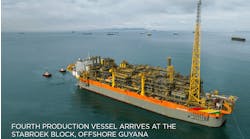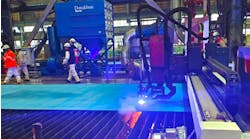Country’s largest offshore project in recent years
Mariner, Equinor’s first operated oil field on the UK continental shelf, began production in mid-August 2019. The heavy oil field is on the East Shetland Platform in block 9/11a in the northern North Sea, about 150 km (93 mi) east of the Shetland Isles and 320 km (200 mi) northeast of Aberdeen. Mariner is not only one of the largest industrial projects in the UK in recent years, but also it is one of the most digitally advanced. Over the next 30 years, Mariner is expected to produce more than 300 MMbbl of oil. Annual average plateau rates are expected to be about 55,000 b/d and up to 70,000 b/d at peak production.
Equinor holds 65.11% equity along with partners are JX Nippon (20%), Siccar Point (8.89%), and ONE-Dyas (6%).
According to Anders Opedal, executive vice president for Technology, Projects and Drilling in Equinor, “With the start-up of Mariner, we have delivered one of the most complex developments in the North Sea and Equinor’s portfolio.”
Discovered by Texaco in 1981, the field has undergone various development studies by different operators. However, due to the complexity of the reservoirs it was left untouched. In 2007, Equinor acquired the operatorship from Chevron. The Mariner oil field consists of two shallow reservoir sections: the Maureen formation at 1,492 m (4,895 ft) and the Heimdal reservoir at 1,227 m (4,026 ft). Both contain heavy oil of about 12-14° API.
Equinor estimates in-place oil of up to 3 Bbbl, 50% higher than the original assumption. Through better understanding of the reservoirs and new seismic technology the recoverable reserves increased 20% from 250 MMbbl to 300 MMbbl of oil.
“With the significant volumes in place, we see clear potential to further increase the oil recovery from the Mariner field and will proactively seek opportunities to do so through the application of new technology, additional drilling and future tieback opportunities,” Opedal said.
In December 2012, the partners sanctioned the more than $7.7-billion Mariner project. According to the operator, the project economics improved after the UK government’s expansion of the Ring Fence Expenditure Supplement.
The field development concept includes Mariner A, a production, drilling and living quarters (PDQ) platform based on a steel jacket with an 850,000-bbl capacity floating storage unit (FSU), Mariner B. Drilling is carried out from the PDQ platform together with a jackup rig assisting during the initial phase. More than 100 wells are expected to be drilled over the first 12-14 years.
The UK government approved the field development plan in February 2013.
Dragados Offshore built the 22,400-ton steel jacket, and SNC Lavalin provided detailed engineering. According to Dragados, this was the largest jacket the yard in Cádiz, Spain, ever built. At 134 m (440 ft) high and with a footprint of 88 x 62 m (289 x 203 ft), it is said to be the largest steel jacket ever built for an Equinor project.
Daewoo Shipbuilding & Marine Engineering (DSME) built the 41,888-ton topsides in South Korea, with CB&I (now McDermott) and RDS providing detailed engineering design. DSME contracted Aker Solutions to provide not only drilling equipment but also engineering, construction, and commissioning services for the hook-up phase. Equinor awarded Aker Solutions a five-year maintenance and modifications services contract.
Odfjell Drilling secured the platform drilling services contract.
Samsung Heavy Industries built the 255-m (837-ft) long Mariner B FSU in South Korea. Samsung commissioned Wärtsilä to supply 45 deep well process and cargo offloading pumps with electric motors and variable speed drive panels, three fire water pump skids, and two ballast pumps. OSM Offshore operates the FSU, which is 2.5 km (1.6 mi) from Mariner A. Mariner B receives, stores, and offloads the oil produced from the field, while providing diluent, a light condensate, to ensure flow assurance. Oil is taken from the FSU to shore via tankers.
Saipem’s semisubmersible crane vessel Saipem 7000 performed the heavy-lift operations.
Subsea 7 constructed and installed 39 km (24 mi) of rigid flowlines and flexible riser systems, associated subsea structures, protection systems, and tie-ins.
Mariner also features what Sembcorp Marine claims is the world’s largest jackup. The 215-m (705-ft) tall Noble Lloyd Noble is based on the GustoMSC CJ70 design. It has an operational air gap of 69 m (226 ft) and can operate in a water depth of up to 150 m (492 ft) in harsh environmental conditions, with a maximum total drilling depth capacity of around 10,000 m (33,000 ft).
This is also the first offshore structure of its kind to fully comply with both Norwegian and UK regulatory standards, according to Sembcorp.
Equinor commissioned Schlumberger Oilfield UK to provide integrated drilling and well services and Baker Hughes to supply production chemicals and services.
Prosafe’s semisubmersible accommodation support vessel Safe Boreas has been operating at Mariner since August 2017.
Digitalization plays a key role in the project. Digital solutions used include Echo, a digital copy of the platform; automated drilling; field worker tools; and digitized logistics to support operational and field maintenance planning.
Sekal installed its automatic drilling control system, DrillTronics, on the Mariner PDQ platform.
Equinor has committed to use wired drill pipe supplied by NOV for the project. The wire inside the drill pipe facilitates high-speed data transfer, with the signals transmitted through the drill pipe estimated to be 10,000 times faster than the pressure waves of the drilling mud in conventional drill pipes.
Opedal added: “We will continue to apply digital solutions and new technology to deliver safe and efficient operations and optimize production.”
Since the development started, UK suppliers have secured contracts worth more than $1.3 billion. According to Equinor, Mariner supports more than 700 long-term jobs and will generate significant revenue in the supply chain for decades to come.
Oil and Gas UK upstream policy director Mike Tholen said: “As the largest offshore development in the UK for a decade, Mariner has utilized pioneering technology to bring onstream a field first discovered nearly 40 years ago. In doing so it has provided thousands of highly skilled jobs across the country during its development and will support many more in the years to come.
“The Mariner field will contribute towards energy security for the next 30 years. With up to 3 Bbbl of oil in place, it contributes to industry’s shared ambition Vision 2035 – which looks to meet as much of the UK’s oil and gas needs from home-produced resources as possible.” •






